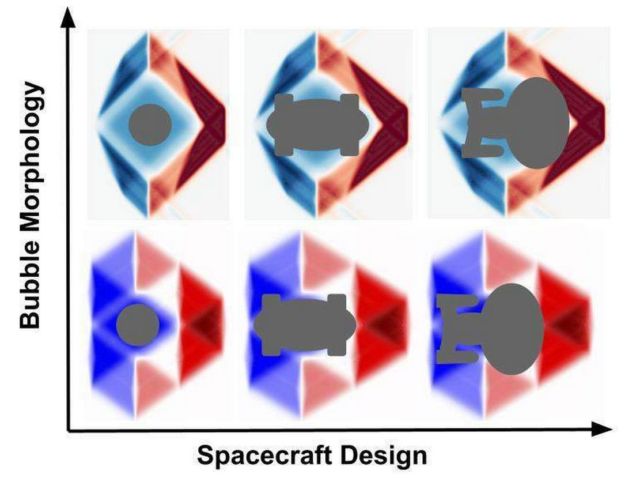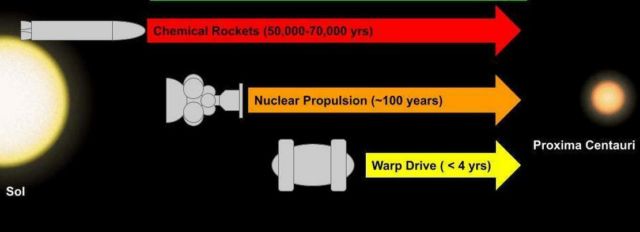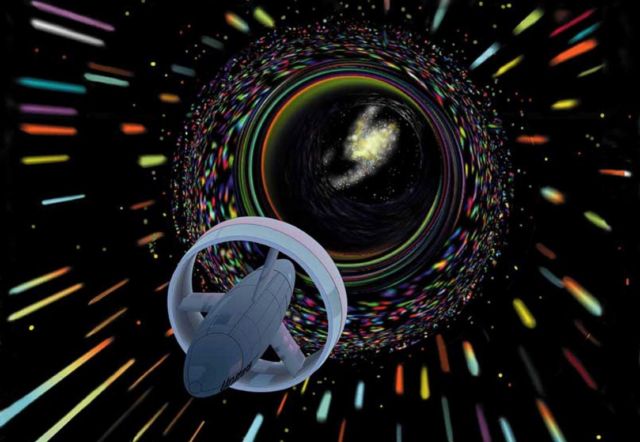Astrophysicist discovers new theoretical hyper-fast soliton solutions, faster-than-light, to travel to nearby stars.
If travel to distant stars within an individual’s lifetime is going to be possible, a means of faster-than-light propulsion will have to be found.
Above: Wormhole travel as envisioned by Les Bossinas for NASA
To date, even recent research about superluminal (faster-than-light) transport based on Einstein’s theory of general relativity would require vast amounts of hypothetical particles and states of matter that have “exotic” physical properties such as negative energy density. This type of matter either cannot currently be found or cannot be manufactured in viable quantities.
In contrast, new research carried out at the University of Göttingen gets around this problem by constructing a new class of hyper-fast ‘solitons’ using sources with only positive energies that can enable travel at any speed. This reignites debate about the possibility of faster-than-light travel based on conventional physics. The research is published in the journal Classical and Quantum Gravity.
 Artistic impression of different spacecraft designs considering theoretical shapes of different kinds of “warp bubbles”. Credit Göttingen University
Artistic impression of different spacecraft designs considering theoretical shapes of different kinds of “warp bubbles”. Credit Göttingen University
The author of the paper, Dr Erik Lentz, analysed existing research and discovered gaps in previous ‘warp drive’ studies. Lentz noticed that there existed yet-to-be explored configurations of space-time curvature organized into ‘solitons’ that have the potential to solve the puzzle while being physically viable. A soliton – in this context also informally referred to as a ‘warp bubble’ – is a compact wave that maintains its shape and moves at constant velocity. Lentz derived the Einstein equations for unexplored soliton configurations (where the space-time metric’s shift vector components obey a hyperbolic relation), finding that the altered space-time geometries could be formed in a way that worked even with conventional energy sources. In essence, the new method uses the very structure of space and time arranged in a soliton to provide a solution to faster-than-light travel, which – unlike other research – would only need sources with positive energy densities. No “exotic” negative energy densities needed.
 Image to show how long it would take different types of spacecraft to travel from our solar system to Proxima Centauri (the nearest known star). Currently, the only option would be to use a chemical rocket meaning a journey time of over 50,000 years. Credit Göttingen University
Image to show how long it would take different types of spacecraft to travel from our solar system to Proxima Centauri (the nearest known star). Currently, the only option would be to use a chemical rocket meaning a journey time of over 50,000 years. Credit Göttingen University
“This work has moved the problem of faster-than-light travel one step away from theoretical research in fundamental physics and closer to engineering. The next step is to figure out how to bring down the astronomical amount of energy needed to within the range of today’s technologies, such as a large modern nuclear fission power plant. Then we can talk about building the first prototypes,” says Lentz.
source Göttingen University






Leave A Comment